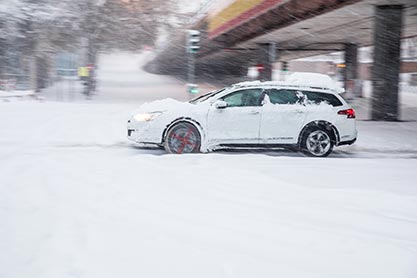
With the weather currently taking an icy turn, revolving our roads into snow-ridden tracks, what better time to inform you of the best ways to drive safely through severe forms of wintery weather. Driving through snow or ice can bring panic to many drivers, but with our tips and advice, we can provide you with the confidence to get from A to B.
It is important to remember firstly that if your journey isn’t essential, it will be safer to remain indoors and off of the roads, but if you do need to travel to a certain destination, here’s how.
Prepare yourself
Planning is key when preparing to drive thorough tough spouts of winter weather. You will need to be taking it steady whilst on the road, so you should allow more time for your journey. Attempting to travel in a rush could lead to risks and hazardous consequences. You will also need to consider the amount of time it will take to fully de-ice your vehicle before setting off. Once on the road, altering your journey around main routes will allow you to travel on clearer, gritted streets, so avoid taking any back-road shortcuts.
There are a few things that you should load into your vehicle that can aid you in a variety of circumstances, from becoming stuck in the snow, pulled over on the side of a dangerously icy road or broken down, such as:
- A winter coat, a pair of gloves, a woollen hat, a scarf and a pair of waterproof, sturdy shoes or boots to keep you warm in case you have to stand outside of your vehicle.
- A phone charger in case you remain stationary for a long period of time and need to keep in contact with roadside assistance.
- A shovel to aid you when driving through thick levels of snowfall.
- An ice-scraper or de-icing spray to keep your windows clear from snow and ice at all times.
- Snacks and water to keep you fed and hydrated in case you remain on a roadside for a prolonged period of time.
- A flask of hot beverages to keep you warm.
- A pair of sunglasses to protect your eyesight from sunbeams.
- Emergency contact details displayed within your vehicle in case of emergency.
Prepare your vehicle
Winter tyres, although not ideal for driving through thick snow, can offer vehicles additional grip when travelling upon wet or slippery roads. Contact your local garage as they may supply a winter tyre fitting service, highly beneficial for those who travel through areas which experience regular spells wintery weather.
Standard tyres should be assessed before taking to the road, ensuring that they are inflated to the correct pressure and that they have at least 3mm of tread.
Some vehicles experience their locks freezing up. A simple spray of WD-40 will prevent this from occurring. If this is unavailable to you, heat your key up with a match or lighter to melt the ice within the lock.
Make sure that your footwell mats are in place before taking to the road. These can prove effective when you find your vehicle stuck in the snow. By placing these behind or infront of your tyres, you should be able to gently manoeuvre out of the pit your tyres have created.
Ensure that you have a full tank of fuel before setting off. This will allow you to divert your journey to a safe place if needed, or allow you to keep your engine running, providing you with warmth if you become stuck.
Tips for the road
When pulling away, do so in 2nd gear whilst lifting the clutch gently, allowing you to avoid wheel spinning which could dig your tyres into a pit, preventing you from moving. As you pick up speed, remain in a high gear, giving you maximum control over your vehicle. Keep a speed which allows you to withhold momentum but avoids you losing control of the vehicle. Make all actions smooth and gentle, such as steering, braking and accelerating.
In wintery road conditions, stopping distances are around ten times greater, so remember to leave additional space between you and the vehicle infront and drive at a speed that doesn’t rely on your breaks as the only method of stopping.
If you find yourself stuck in the snow, try these simple yet effective tips:
- Don’t try to drive out if you experience a wheelspin as this will dig you in deeper
- Remain stationary but gently turn your wheels from left to right, pushing the snow out of the way and widening the pit around your tyres
- Use your shovel to clear snow from the front of your vehicle. Lay your footwell mats down to allow you to ease your way out of the pit
If these methods fail, you may need to abandon your vehicle until the weather eases (if safe to do so), or call for roadside assistance. You should wait nearby or within your vehicle, but should always observe to see if the exhaust is blocked with snow. If it is clear, you are safe to leave your engine running without risking the emission of toxic carbon monoxide gasses into your vehicle.
For further information on how to safely complete your journeys this snowy season, or to book your vehicle in for a specialist winter service, get in touch with a member of our Bromley Vehicle Test Centre team by calling 020 8460 6666 today.
